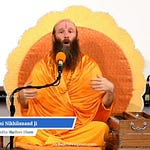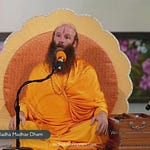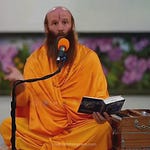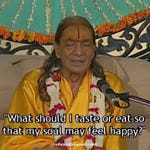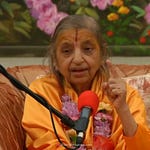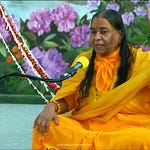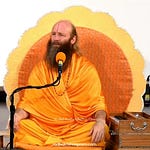The class of sakām bhakti, or that is, of sagun sakar Brahma, or as I had already told you all the last time, dasya bhav, sakhya bhav, vatsalya bhav, madhurya bhav devotees (also in that madhurya bhav, sadharani rati, samanjas rati or samartha rati) are all various classes.
There is the Master-servant relationship, known as dasya bhav, and then above it is sakhya bhav, the intimate friend-friend relationship, the eternal companion as God is, and to build that relationship like Shridama, Mansukha had with Shri Krishna.
There is Vatsalya bhav where God becomes your child and you become the parent with that kind of emotion, that kind of bhav - your sentiment and feeling. Opposite to that is shant bhav. In shant bhav,
“He’s the father and I the child”, a general concept.
“He is the king, the governor and I am governed and the subject.”
But as soon as we get into the vatsalya bhav it becomes vice versa,
“The Supreme Almighty Lord is my most darling, beloved, my dear child.” And you have the feeling of either a father or a mother, like Nand Baba, Yashoda Maiya. So that’s vatsalya bhav.
And then above vatsalya bhav is madhurya bhav, that’s the topmost of the bhav.
These are various levels of devotion or classes of bhakti, of devotion. And (based on) the limit of bhakti, one experiences the Divine happiness, the Divine bliss.
So, for the Vedricha gopi, the experience of Divine happiness from her Divine beloved Shyamsundar, compared to the happiness the Golok gopi is enjoying from Shyamsundar also differs. So the difference of opinion would be there. So for the Vedricha gopi, Shamsundar is extremely hard-hearted. But for the Golok gopi, Shyamsundar is extremely tender-hearted. And the debate is going on about this particular issue.
And also another point to mark here is this: Apart from the different classes and levels of devotion, the different levels of experience of the bliss of God, there is also this major point or philosophy that we need to keep in our minds, and that is that mahabhav bhakti is just not any material matter. It’s not like the happiness we experience, the joy or pleasure or happiness we experience. Through mahabhav bhakti, the mahabhav class of ras is experienced. Now this is the highest, the supreme class and both these gopis are on that level, on that height where they have already experienced and are intoxicated in Maharas ras. Both the gopis have attained Maharas ras. And this Maharas ras of mahabhav bhakti is not any material matter.
This mahabhav bhakti ras is the ras, the happiness, the bliss, that pours and showers from every pore and every fiber of Shyamsundar Himself, from Shri Krishna’s Divine body. From this Divine body ras is being poured, the mahabhav ras. And the mahabhav bhakti, the devotee who has done the bhakti of this mahabhav bhakti class is drinking and getting intoxicated in mahabhav ras.
So it is from Shyamsundar Himself that this ras is being experienced. The supreme-most of the ras,
रस तमः परमहः
ras tamaha paramaha.
“There is no ras beyond this ras, no bliss beyond this bliss, no happiness beyond this happiness.”
And to this extent these gopis, especially the Vedricha gopi, to the extent, to the limit, are experiencing bliss. All the bliss experienced by all the devotees, be it sakam bhakt, dasya bhakt, or sakhya bhav bhakt, vatsalya, madhurya, all the devotees experience and receive infinite bliss. Bliss is never limited. Remember this. Happiness is never limited. Just as God is Divinely infinite, so is every shakti of God infinite in nature and so is the Divine happiness infinite in nature. So don’t think that one experiences inferior ras or nectar and the other experiences superior happiness. No, no, no. Happiness is all Divine and happiness is all infinite and it cannot be talked about or expressed; it’s unexplainable.
However, the level of ras that the Rasik or that the Mahapurush experiences is very personal. With the grace of Shree Maharaj Ji only we have come to learn that there are different levels. Otherwise we wouldn’t have ever known, because it is the same eyes, exactly and precisely the same eyes of Shyam Sundar, of Shri Krishna, that Surdas saw and the same eyes that Tulsidas Ji saw in the Ram form or Krishna form, or whatever form. The same Divine eyes that Mirabai saw, the same Divine eyes that Prahlad saw, the same Divine eyes that Dhruv saw and the same Divine eyes that the Braj gopis saw. It’s the same one ‘eyes’, but the experience of the Divine bliss is very different in each one of them, and that cannot be explained.
So we just have to understand this much. And it’s why I’m explaining this so that you can understand why Shree Maharaj is trying to take us onto the path of raganuga bhakti, the path of unconditional love, unselfish love, for Guru and Govind.



